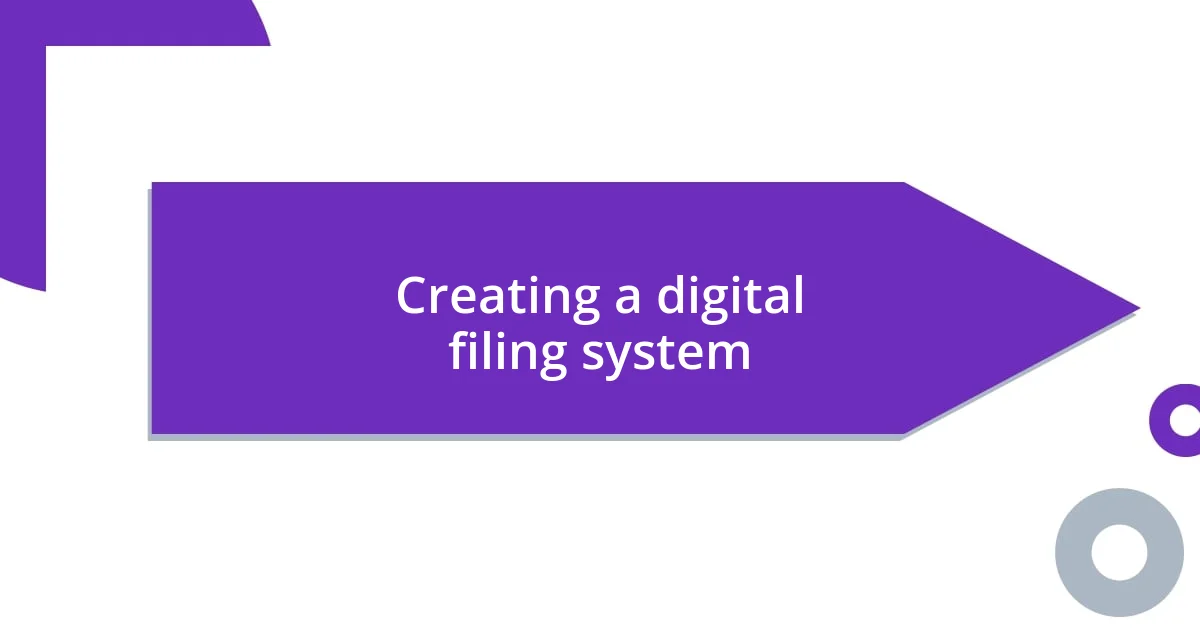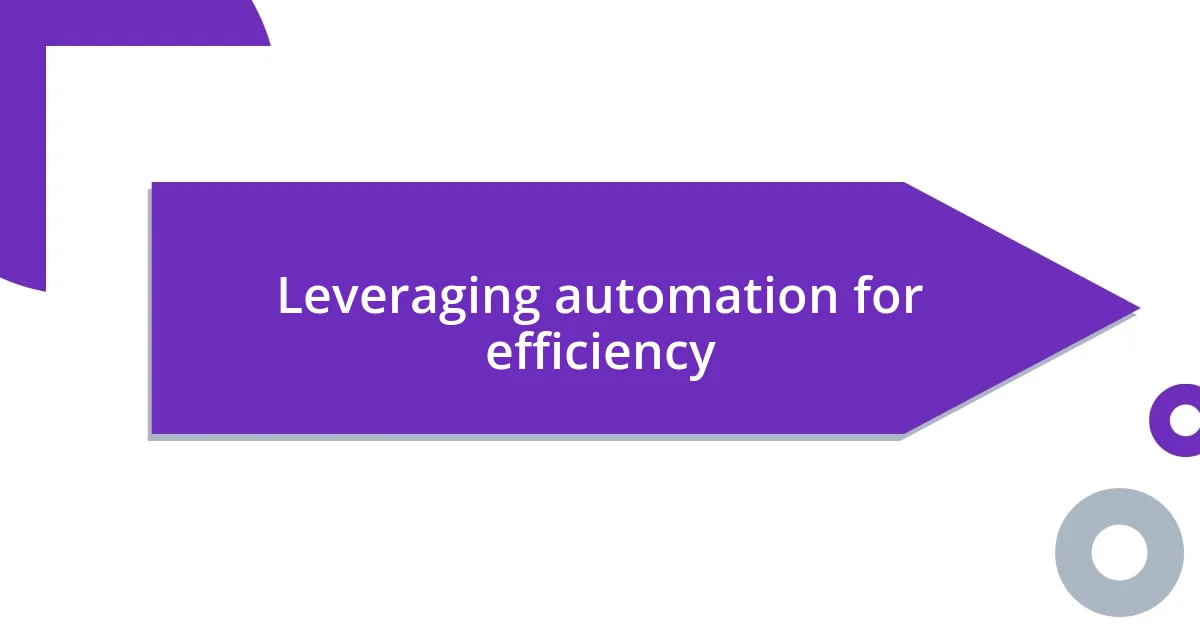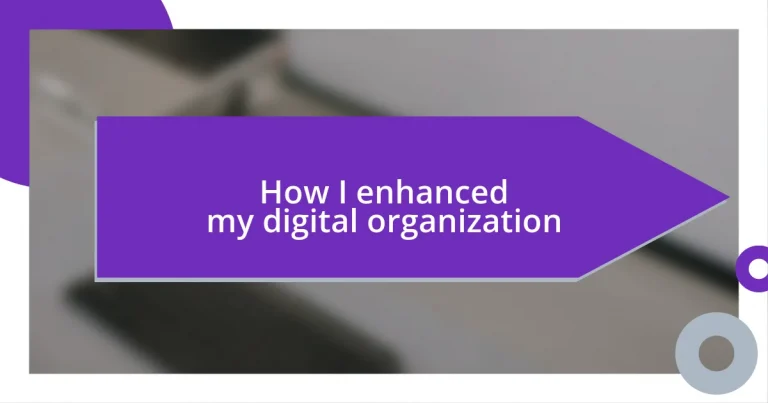Key takeaways:
- Implementing a structured folder hierarchy and keyword tagging significantly streamlines digital file management, enhancing productivity and reducing the time spent searching for documents.
- Regular digital audits help identify and eliminate clutter, allowing for better organization and reflection on priorities, ultimately creating space for new, relevant projects.
- Leveraging automation tools for tasks such as email filtering and project management can enhance efficiency, freeing up time to focus on more important and creative endeavors.

Understanding digital organization techniques
Digital organization techniques can sometimes feel overwhelming, especially when faced with the sheer volume of information we encounter daily. I remember when I first started exploring these methods—I was amazed at how something as simple as tagging files could streamline my workflow. Have you ever found yourself searching endlessly for a document? That’s where techniques like keyword tagging really shine, allowing you to retrieve information in just a few clicks.
As I delved deeper into digital organization, I discovered the value of creating a structured folder hierarchy. Initially, my digital files felt like a chaotic mess, mirroring my offline life. But designing a clear folder structure not only made finding things easier but also gave me a sense of control and clarity. Doesn’t it feel good to open your computer and see everything in its right place?
Using tools like digital notes has revolutionized my approach to organization. I vividly recall when I transitioned from sticky notes scattered across my desk to using a note-taking app. It completely transformed how I capture ideas on-the-go. Are you still relying on paper? I highly recommend trying a digital note tool; the immediate search functionality alone can save you countless hours!

Identifying your digital clutter
Identifying your digital clutter is the first step in regaining control over your virtual space. I still remember the cluttered desktop I had, littered with random files and unneeded applications. It was like navigating through a maze of distractions—nothing felt accessible. I started by conducting a digital audit, which encouraged me to analyze what I really needed and what could be discarded. This process was revealing and surprisingly liberating.
As I sifted through my digital files, I noticed a pattern; many documents were either duplicates or outdated versions. At one point, I had three different sets of the same contract—each one slightly altered. It was embarrassing to confront. By identifying duplicates, I not only freed up storage space but also simplified my workflow. I felt lighter, like I had removed unnecessary weight from my digital life.
Moving beyond files, the apps I used played a significant role in my digital clutter. I found myself overrun by apps that I downloaded on a whim but never truly utilized. In one instance, I had ten different to-do list applications! I finally consolidated them down to one that suited my needs perfectly. This kind of assessment can be an eye-opener. Have you thought about how many apps you actually use on a regular basis? Streamlining these can clear up not just digital space, but also mental energy.
| Aspect | Before Decluttering | After Decluttering |
|---|---|---|
| File Organization | Chaotic, random files | Structured and easy access |
| Duplicates | Multiple versions of the same document | Single, updated versions only |
| App Usage | Too many non-essential apps | Single, effective app for tasks |

Tools for effective digital organization
When it comes to digital organization, choosing the right tools truly makes a world of difference. For me, utilizing a combination of cloud storage and productivity apps helped turn my chaotic digital landscape into a curated collection of organized resources. I distinctly recall the sense of relief washing over me as I transferred important files to a cloud platform, allowing me to access them anytime and anywhere without fear of losing them. Just imagine knowing your important documents are securely housed and easily retrievable!
- Cloud storage solutions (e.g., Google Drive, Dropbox): Great for accessible and secure storage.
- Task management tools (e.g., Todoist, Trello): Perfect for organizing tasks and keeping projects on track.
- Note-taking apps (e.g., Evernote, Notion): Ideal for capturing and organizing ideas in one place.
- File organization software (e.g., Hazel, FileOptimizer): Helpful for automating file management tasks.
- Time management apps (e.g., RescueTime, Toggl): Essential for tracking where your time goes and optimizing productivity.
Every tool serves a specific purpose and enhances how I tackle the endless stream of data. For example, when I first integrated a visual project management tool, I was astounded by how it transformed my approach to team collaborations. The clarity of seeing tasks laid out visually not only improved my engagement but also made it feel like a well-oiled machine. I felt more accountable, both to my team and myself. Have you experienced that feeling of synergy when everyone knows what to do? It’s empowering!

Creating a digital filing system
Creating an effective digital filing system has been a game changer for me. At first, I struggled to find my vital documents, wasting precious minutes searching through layers of inconsequential files. I decided to categorize everything logically, using folders named by projects and deadlines. This simple action transformed my computer from a chaotic digital jungle into a streamlined workspace, instantly making important files easier to find—an incredible relief!
One tip that genuinely helped was establishing a color-coding system for my folders. Color-coding not only added a personal touch but also allowed me to visually distinguish between different categories at a glance. I felt a sense of accomplishment whenever I organized a folder and chose a color that resonated with the project. Have you ever felt a rush of satisfaction from organizing something? It’s such a small change, yet it made my digital environment feel so much more personal and inviting.
It’s crucial to dedicate time regularly to maintain this system, too. At first, I thought I could set it up and leave it be, but I quickly learned that without routine maintenance, clutter creeps back in. Now, I schedule a monthly “digital decluttering day,” where I review each folder and delete unnecessary files. This practice not only keeps my files in check but also lets me reflect on my projects and progress. Isn’t it fascinating how a little organization can boost creativity and focus?

Maintaining organization with regular audits
I can’t stress enough how transformative regular audits have been for my digital organization. Initially, I viewed these audits as tedious tasks, but they quickly became opportunities for reflection and clarity. Every time I sit down to review my digital files, I’m often surprised by what I find lurking in the depths of my cloud storage. It’s like opening a time capsule! Discovering forgotten projects reminds me of past accomplishments and keeps me grounded in my journey.
During my last audit, I stumbled upon old documents marked “urgent” from a project that had long been completed. It was an eye-opener. I realized that my priorities had shifted, and I no longer needed those files cluttering my space. This process not only decluttered my digital environment, but it also reignited a sense of purpose. How often do we hold on to things that no longer serve us? By letting go, I was able to create space for new ideas and projects that truly resonate with who I am today.
Incorporating regular audits into my routine means I now approach them with excitement rather than dread. I often use the time to reassess my goals and identify any areas that need more focus. It’s almost like having a mini brainstorming session with myself! I find that asking myself questions—like “What do I want to achieve in the next month?”—guides me in organizing my files more effectively. Adopting this habit has made a significant difference, and I believe it could do the same for anyone looking to enhance their digital organization.

Leveraging automation for efficiency
Leveraging automation has been one of the most impactful strategies in my quest for digital efficiency. I remember when my to-do list felt overwhelmingly long, filled with repetitive tasks that drained my energy. Then, I discovered automation tools that could schedule emails, remind me of deadlines, and even sort incoming files into designated folders. The relief was palpable! Suddenly, I had time back in my day, allowing me to focus on the projects that truly needed my attention. Have you ever wished for just a few extra hours in your week? Automation can actually provide that gift.
One of my favorite examples of this is using email filters. Initially, my inbox was a swirling tornado of unread messages, lost amidst the constant influx of updates and promotions. By setting up custom filters, I was able to sort emails by priority as they arrived. This transformation turned my inbox from overwhelming chaos into a manageable dashboard. It’s fascinating how such a small adjustment can create such profound clarity. When I see important emails immediately categorized, I feel a sense of control returning to my digital life.
Automating routine tasks also allowed me to streamline my project management. I began using tools like Trello and Asana, which offer features that send reminders or update team members automatically. I still remember the first time I automated a recurring task—I couldn’t help but smile as I realized I wouldn’t have to remember it anymore. How liberating is it to let go of mental clutter? With these systems in place, I now spend less time tracking tasks and more time being creative, which is where my energy truly thrives.














